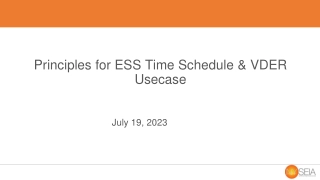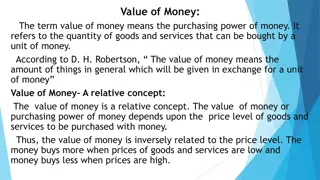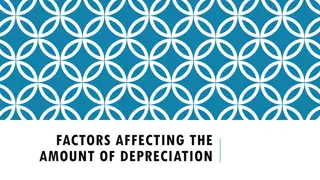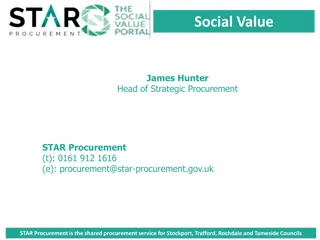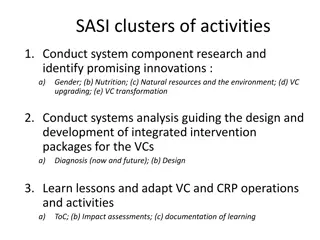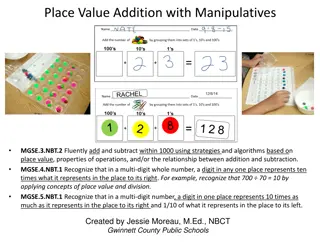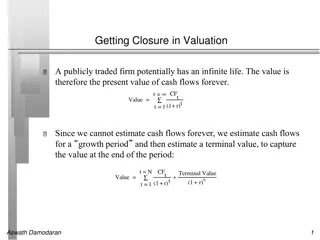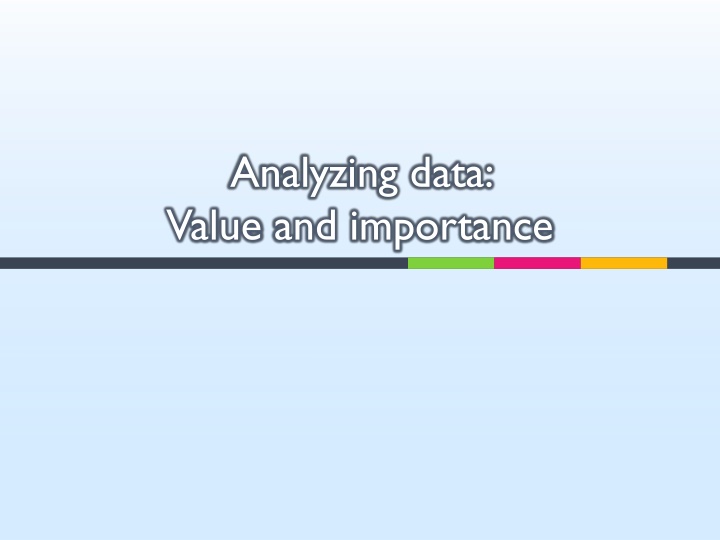
Data Analysis, Causation, and Importance in Evaluation
Explore the significance of analyzing data, inferring causation, and determining importance in evaluation processes. Dive into strategies for drawing conclusions, adding value to descriptive data, and avoiding subjectivity. Understand the process of assigning labels to dimensions or components to indicate their importance.
Download Presentation

Please find below an Image/Link to download the presentation.
The content on the website is provided AS IS for your information and personal use only. It may not be sold, licensed, or shared on other websites without obtaining consent from the author. If you encounter any issues during the download, it is possible that the publisher has removed the file from their server.
You are allowed to download the files provided on this website for personal or commercial use, subject to the condition that they are used lawfully. All files are the property of their respective owners.
The content on the website is provided AS IS for your information and personal use only. It may not be sold, licensed, or shared on other websites without obtaining consent from the author.
E N D
Presentation Transcript
Analyzing data: Value and importance
Review How to infer causation: 8 strategies? How to put them together? S519
Values in evaluation (DCh6) Adding value to descriptive data to make our evaluation explicit Our goal Using quantitative value to evaluate the quality or value of the evaluand in a particular context. Build up our conclusions based on a level of certainty What are values: good , valuable , worthwhile S519
Values in evaluation Adding values to descriptive data collected about Process, outcomes, costs, comparisons, exportabilities; or Situated dimensions or components Weighting all the strengthens or weaknesses of these values to draw overall conclusion about the evaluand. How Importance weighting Merit determination synthesis methodology S519
Subjective Before we go for methodology, we have to answer the question: Whether our data are subjective S519
Three types of subjectives (Scriven, 1991) Subjective 1: Inappropriate application of personal or cultural preferences/biases: arbitrary, idiosyncratic, unreliable, highly personal (i.e., based purely on personal preference, cultural biases, gender biases) Subjective 2: assessment or interpretation by a person, rather than guidelines Using well-founded expert judgments Robust evidence Subjective 3: about a person s inner life or experiences (e.g., headaches, fears, beliefs, emotions, stress) Usually not independently verifiable S519
Avoid Subjective We provide our conclusion based on certainty in the relevant decision-making context Keep the whole evaluation well documented and justified All evaluations, especially high-stakes ones, should be meta-evaluated (i.e., evaluation itself should be evaluated) S519
Determining importance (D-ch7) Importance determination is the process of assigning labels to dimensions or components to indicate their importance. Importance weighting Prioritize improvements Identify whether identified strengths or weakness are serious or minor Work out whether an evaluand with mixed results is doing fairly well, quite poorly, or somewhere in between. S519
Determining importance (D-ch7) Different evaluations Dimensional evaluation Looking at multiple dimensions of merit that pertain to the evaluand as a whole rather than separately to its parts. Component evaluation Looking at each of the evaluand s components (or parts) separately and then synthesizing these findings to draw conclusion about the evaluand as a whole. Each component can be evaluated on several dimensions that pertain to this component only rather than to the evaluand as a whole. Holistic evaluation Looking evaluation as a whole without division into dimensions or components S519
When to use what Component analysis Evaluating policies, programs, or interventions that have several quite distinct parts An international program consisting of projects implemented in different locations (e.g. WIC in IU) A government policy includes multiple policy measurements (e.g. Juvenile delinquency) An organizational transformation includes several distinct interventions (e.g. Career support) S519
When to use what Dimensional evaluation Entities whose quality or value is experienced by consumers on multiple dimensions that pertain to the evaluand as a whole Product evaluation (i.e. Car evaluation) S519
When to use what Holistic evaluation Unusual in the evaluation of programs, policies and other large complex evaluands. More common in personnel, product and service evaluation (expertise-oriented evaluation) Judging the overall quality of a sample of writing Grading essays Classroom teaching Athletic performance cosmetics S519
Determining the importance of dimensions S519
Determining the importance of componentss S519
Determining importance Weak performance on minor criteria (e.g. dimensions, components) may be no big deal, But weak performance on important criteria can be very serious issues. S519
Determining importance: 6 strategies 1. having stakeholders or consumers vote on importance Commonly used in both participatory and nonparticipatory evaluations Collecting opinions from everybody Assumptions Each person is well informed Stakeholder s belief what (s)he chooses is important Stakeholder s important should be treated equally Pros and cons? S519
Determining importance: 6 strategies 2. Drawing on the knowledge of selected stakeholders Using selected stakeholder input to guide the assignment of importance weightings Collecting opinions from selected experts Setting up the Bars A bar is a defined minimum level of criterion performance below which the evaluand is considered completely unacceptable, regardless of performance on other criteria. S519
Determining importance: 6 strategies 2. Drawing on the knowledge of selected stakeholders Assumptions: The stakeholders should be sufficiently well informed to provide valuable relevant information The combination of stakeholder input will provide sufficient certainty about importance for the given decision-making context Pros and cons? S519
Determining importance: 6 strategies 3. Using evidence from the literature Literature review Evaluations of similar evaluations in similar contexts Research documenting the key drivers (or strongest predicators) of success or failure with this type of evaluand. Assumptions The volume and quality of the available research is sufficient to judge the importance The context of other research is sufficiently similar to yours and therefore that the findings can be reasonably applied to your setting Pros and cons? S519
Determining importance: 6 strategies 4. Using specialist judgment When you have tight timeline, no time for gathering stakeholders and looking for literature Identify one or two (or two or more) well-known specialists in the domain Better be supplemented with other evidence Pros and cons? S519
Determining importance: 6 strategies 5. Using evidence from the needs and values assessments Determining the importance of criteria (dimensions) Any frequently mentioned characteristics? Looking for poor-performing evaluators that cause serious problem Looking for top-notch evaluators that have dramatic impacts on success S519
Determining importance: 6 strategies 5. Using evidence from the needs and values assessments Determining the importance of components Severity of dysfunction addressed (primary consideration) Scarcity of alternatives: no other options for addressing the need. Intent to use alternatives: if the evaluand component in question did not exist. Rubrics to measure (Table7.4, 7.5 and 7.6, 7.7, 7.8 (combined)) Prons and cons? S519
Determining importance: 6 strategies 6. Using program theory and evidence of causal linkages When criteria or components are linked to needs through a complex logic chain. Such as soft skills or attributes (e.g., inspirational leadership, self-esteem, stress management, a kind of instrumental needs) More upstream variables (see Exhibit 7.5) How to estimate the strengths of the links Interview Analyze your previous data ... S519
Strengths and weaknesses of the six strategies Always think whether they are applicable Choose mulitple of them S519
Exercise Table 7.10 (class dissusion) Form a group Discuss which strategies you will choose to determine the importance for the student services in the school health program (see Table 7.8) Discuss which strategies you will choose to determine the importance for your group project S519

